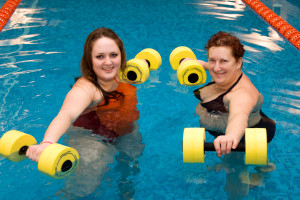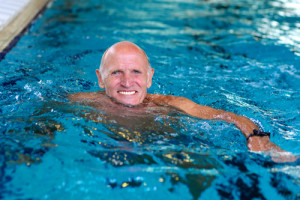Water can be used as a therapeutic and healing medium for rehabilitation, swim training as well as for fun and relaxation. Aquatics therapies have been used for physical and spiritual cleansing in religions around the world for centuries.
 There has been extensive research to explore the various uses, aides, restrictions, and safety measures relating to the use of water and the individual who chooses aquatics as a form of therapy or training. Included in that work is a variety of patient diagnosis, current states of health and the necessary modifications for particular swim strokes, stability, and safety.
There has been extensive research to explore the various uses, aides, restrictions, and safety measures relating to the use of water and the individual who chooses aquatics as a form of therapy or training. Included in that work is a variety of patient diagnosis, current states of health and the necessary modifications for particular swim strokes, stability, and safety.
What has been discovered is the level in which the aquatic instruction and props (if needed) would vary from not just student to student, but level of injury or skill level of the participant. Though water is a natural place to engage in healing, exercise and rehabilitation, much care is needed for a safe and beneficial experience. Exercising in water is quite different than exercising on land.
There are different reasons for choosing aquatics as an exercise medium. Aside from buoyancy and the feeling of weightlessness that comes with it, the hydrostatic pressure and velocity of the water gives one a feeling of support while in the water.
Five Important Factors
The type of aquatics therapy that is recommended would depend on the individual and the particular circumstances specifically relating to them. There are five important factors that must be considered when working with aquatics: 1) Gender, 2) Height, 3) Fitness Level, 4) Whether or not the person smokes and 5) If there is any known disease present. Any of these factors will have an effect on the air volume capacity of a given person.
Ideally there will be a team of licensed professionals working with the patient or student on their road to fitness and wellness. This is known as the Lyton Model (pictured below). It is imperative that the aquatics instructor understand the physiological responses to the body when immersed during any type of aquatic exercise or training. The heart, kidneys and adrenal glands are immediately impacted with immersion due to the shifts in blood flow (stroke volume) caused by the hydrostatic pressure. This change will shift depending on the level of the submersion. Example; waist, chest or chin height, the effects on the body will differ.

Lyton Model
Because water is so versatile, it can be used to treat injuries involving the muscular skeletal and the neuromuscular systems as well. In addition to the above mentioned properties of water, the thermal influence, viscosity, drag and turbulence can all be used and adjusted to produce: relaxation, pain reduction, edema reduction, increase nutrients and increase inflammatory mediators. Muscle tone can be improved and spasms can be reduced. The bones of the body are also said to be strengthened when immersed in water.
As with any exercise, the way in which one breathes is extremely important and breath control should be mastered. The patient or client should not be afraid of the water or be afraid to submerge the face, ears or head under water. Though the reasons for attending aquatics therapy may be different from one person to another, certain skills are necessary as a safe practice measure.
Specific skill training; fall prevention, balance strategies, induced movement and core stabilization therapies are important activities that should be in practice when working in the water. There are different methods and props to aid in accomplishing these goals if someone is having difficulty. The treatment goal will ultimately depend on the individual in training or the prescribed rehabilitation.
 The modifications that have to be made for an individual with an upper body amputation will differ from the modifications that need to be made for someone with a lower body amputation. The location of the amputation of the limb is also relevant to the necessary adjustments. The adjustments and aides for someone who has suffered from cerebrovascular hemiparesis will be different from someone who suffers from arthritis pain or who is a paraplegic.
The modifications that have to be made for an individual with an upper body amputation will differ from the modifications that need to be made for someone with a lower body amputation. The location of the amputation of the limb is also relevant to the necessary adjustments. The adjustments and aides for someone who has suffered from cerebrovascular hemiparesis will be different from someone who suffers from arthritis pain or who is a paraplegic.
The trained aquatics therapists will recognize whether or not a patient or client is in need of a supportive aide (and which one in particular), if the patient needs to work longer on a specific exercise or if they are ready to progress. It is important for the therapist to be “hands on” in the water not just as a means of safety and to assist in recovery strokes but also as needed, physically change the dynamics of the water that is in close proximity to the client and his/herself as a therapeutic aide.
Talk to your healthcare provider to see if aquatic therapy or aquatic rehabilitation is the right option for you.
Michelle D. Talbot-Bey, BCTMB specializies in Personalized and Functional Medicine which includes Prevention, Diagnosis, and Treatment. She owns Pleasures II Wellness Natural Health Center in Woodbridge, VA, based on the ancient teachings and practices of Ayurveda. She offers therapeutic massage, mind/bodywork therapies, in depth consultations and natural pharmaceutical approaches and recommendations for Holistic healthcare, prevention, maintenance, and relief from chronic diseases. She has also completed the AFPA Aquatics for Rehabilitation and Fitness course.
